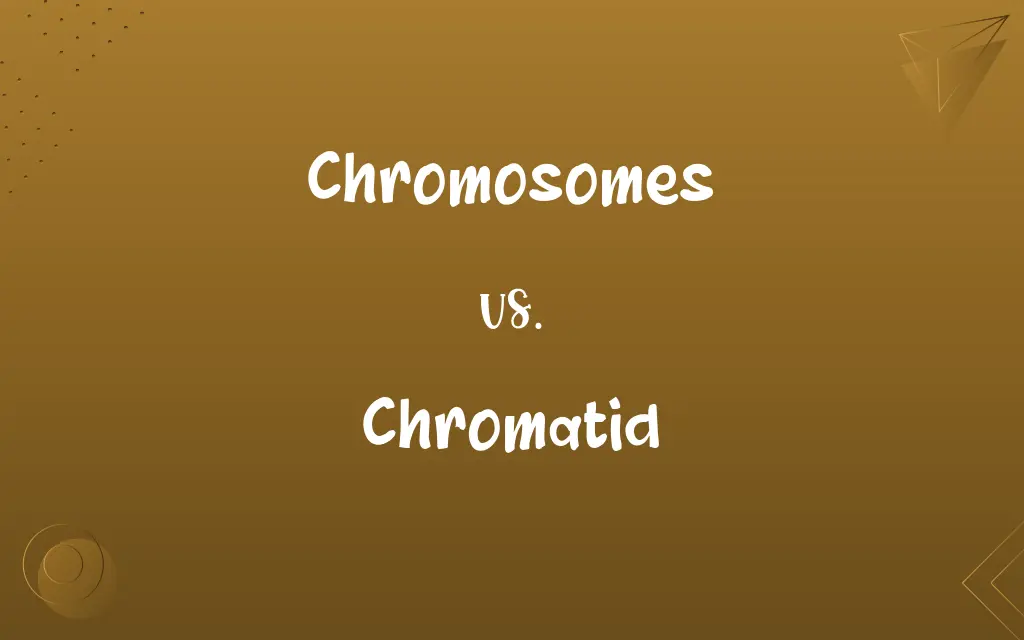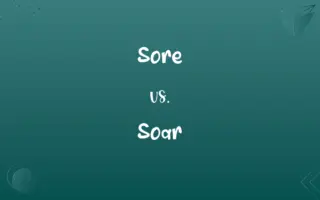Chromosomes vs. Chromatid: Know the Difference

By Shumaila Saeed || Updated on February 20, 2024
Chromosomes are structures containing DNA; chromatids are halves of duplicated chromosomes, joined at the centromere.

Key Differences
Chromosomes are long, thread-like structures composed of DNA and proteins, containing genetic information. Chromatids, on the other hand, are each of the two identical halves of a duplicated chromosome, joined together at a central point called the centromere.
Shumaila Saeed
Feb 18, 2024
Chromosomes exist in cells during all stages of life, carrying genes that determine hereditary traits. Chromatids form during cell division (specifically during the S phase of interphase) and are crucial for the accurate segregation of genetic material into daughter cells.
Shumaila Saeed
Feb 18, 2024
In a normal human cell, there are 46 chromosomes, organized into 23 pairs. After replication, each chromosome consists of two chromatids, which means there are technically 92 chromatids in a cell prior to division. However, these chromatids are still part of their respective chromosomes until they are separated during mitosis or meiosis.
Shumaila Saeed
Feb 18, 2024
During mitosis, chromosomes first replicate into two chromatids. These chromatids then separate and move to opposite poles of the cell, ensuring each new cell receives an identical set of chromosomes. This process is crucial for genetic consistency across cells.
Shumaila Saeed
Feb 18, 2024
Chromosomes are key to maintaining genetic stability through generations, while chromatids play a critical role in genetic variation, especially during meiosis, where crossing over and recombination between chromatids lead to genetic diversity in offspring.
Shumaila Saeed
Feb 18, 2024
ADVERTISEMENT
Comparison Chart
Definition
Structures containing DNA and proteins.
Halves of duplicated chromosomes, joined at the centromere.
Shumaila Saeed
Feb 18, 2024
Formation
Present in cells at all times, carrying genes.
Form during cell division, crucial for gene segregation.
Shumaila Saeed
Feb 18, 2024
Count in Cells
46 in human cells, organized into 23 pairs.
92 after replication, part of their respective chromosomes.
Shumaila Saeed
Feb 18, 2024
Role in Cell Division
Carry genetic information, replicate into chromatids.
Separate to ensure identical genetic material in new cells.
Shumaila Saeed
Feb 18, 2024
Genetic Contribution
Maintain genetic stability across generations.
Contribute to genetic variation, especially in meiosis.
Shumaila Saeed
Feb 18, 2024
ADVERTISEMENT
Chromosomes and Chromatid Definitions
Chromosomes
Thread-like structures containing genetic information.
The human genome is organized into 23 pairs of chromosomes.
Shumaila Saeed
Jan 11, 2024
Chromatid
Each half of a duplicated chromosome.
During mitosis, chromatids separate to form new cells.
Shumaila Saeed
Jan 11, 2024
Chromosomes
Essential for the process of cell division and replication.
During mitosis, chromosomes ensure each daughter cell gets a complete genome.
Shumaila Saeed
Jan 11, 2024
Chromatid
Key players in the accurate distribution of genetic material.
Chromatids ensure genetic material is evenly divided between daughter cells.
Shumaila Saeed
Jan 11, 2024
Chromosomes
Carriers of genes and hereditary traits in cells.
Genetic disorders are often due to mutations in specific chromosomes.
Shumaila Saeed
Jan 11, 2024
ADVERTISEMENT
Chromatid
Contribute to genetic diversity through recombination.
In meiosis, crossing over between chromatids leads to genetic variation.
Shumaila Saeed
Jan 11, 2024
Chromosomes
Composed of DNA and protein, forming the genome.
Chromosomes are visible under a microscope during cell division.
Shumaila Saeed
Jan 11, 2024
Chromatid
Joined at a centromere, crucial for cell division.
The centromere holds the two chromatids together until they are ready to separate.
Shumaila Saeed
Jan 11, 2024
Chromosomes
Organized structures within the cell nucleus.
Scientists study chromosomes to understand genetic diseases.
Shumaila Saeed
Jan 11, 2024
Chromatid
Form during the replication phase of a cell cycle.
Chromatids are created when a chromosome duplicates its DNA.
Shumaila Saeed
Jan 11, 2024
Chromosomes
A linear strand of DNA and associated proteins in the nucleus of eukaryotic cells that carries the genes and functions in the transmission of hereditary information.
Shumaila Saeed
Jan 11, 2024
Chromatid
Either of the two daughter strands of a replicated chromosome that are joined by a single centromere and separate during cell division to become individual chromosomes.
Shumaila Saeed
Jan 11, 2024
Chromosomes
A circular strand of DNA in bacteria and archaea that contains the hereditary information necessary for cell life.
Shumaila Saeed
Jan 11, 2024
Chromatid
(genetics) After DNA replication, either of the two connected double-helix strands of a metaphase chromosome that separate during mitosis.
Shumaila Saeed
Jan 11, 2024
Chromatid
One of two identical strands into which a chromosome splits during mitosis.
Shumaila Saeed
Jan 11, 2024
Chromatid
One of two identical strands into which a chromosome splits during mitosis
Shumaila Saeed
Jan 11, 2024
Repeatedly Asked Queries
What is a chromatid?
A chromatid is one half of a duplicated chromosome, joined at the centromere.
Shumaila Saeed
Feb 18, 2024
How do chromatids form?
Chromatids form during cell division when chromosomes replicate their DNA.
Shumaila Saeed
Feb 18, 2024
What role do chromosomes play in heredity?
They carry genes that determine hereditary traits.
Shumaila Saeed
Feb 18, 2024
Do chromatids separate during mitosis or meiosis?
Chromatids separate during both mitosis and meiosis.
Shumaila Saeed
Feb 18, 2024
Can chromosomes mutate?
Yes, mutations can occur in chromosomes, leading to genetic disorders.
Shumaila Saeed
Feb 18, 2024
Are chromosomes visible under a microscope?
Yes, particularly during cell division.
Shumaila Saeed
Feb 18, 2024
How many chromosomes are in a human cell?
There are 46 chromosomes, organized into 23 pairs.
Shumaila Saeed
Feb 18, 2024
What is the centromere's role in chromatids?
The centromere holds chromatids together until they are ready to separate.
Shumaila Saeed
Feb 18, 2024
Do chromatids exist outside of cell division?
No, they specifically form and exist during cell division.
Shumaila Saeed
Feb 18, 2024
What are chromosomes?
Structures in cells that contain DNA and genetic information.
Shumaila Saeed
Feb 18, 2024
What is chromosomal crossover?
It's a process during meiosis where chromatids exchange genetic material.
Shumaila Saeed
Feb 18, 2024
How are chromosomes counted in cells?
They are typically counted during metaphase of cell division.
Shumaila Saeed
Feb 18, 2024
Can environmental factors affect chromosomes?
Yes, factors like radiation and chemicals can cause chromosomal damage.
Shumaila Saeed
Feb 18, 2024
Why are chromatids important in cell division?
They ensure accurate segregation of genetic material into daughter cells.
Shumaila Saeed
Feb 18, 2024
Can changes in chromosome number affect an organism?
Yes, changes in chromosome number can lead to developmental and genetic disorders.
Shumaila Saeed
Feb 18, 2024
Do chromosomes differ between species?
Yes, different species have different numbers and structures of chromosomes.
Shumaila Saeed
Feb 18, 2024
How do chromosomes affect genetic disorders?
Abnormalities in chromosome structure or number can lead to genetic disorders.
Shumaila Saeed
Feb 18, 2024
Are all chromatids identical?
Yes, they are identical copies of their parent chromosome.
Shumaila Saeed
Feb 18, 2024
How do chromatids contribute to genetic variation?
Through processes like crossover and independent assortment during meiosis.
Shumaila Saeed
Feb 18, 2024
What happens to chromatids during meiosis?
They undergo recombination and separate into gametes, contributing to genetic diversity.
Shumaila Saeed
Feb 18, 2024
Share this page
Link for your blog / website
HTML
Link to share via messenger
About Author
Written by
Shumaila SaeedShumaila Saeed, an expert content creator with 6 years of experience, specializes in distilling complex topics into easily digestible comparisons, shining a light on the nuances that both inform and educate readers with clarity and accuracy.









































































